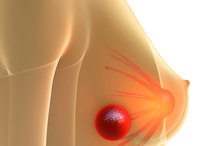What does fact checked mean?
At Healthfully, we strive to deliver objective content that is accurate and up-to-date. Our team periodically reviews articles in order to ensure content quality. The sources cited below consist of evidence from peer-reviewed journals, prominent medical organizations, academic associations, and government data.
- BMC Molecular Biology: Human Single-Stranded DNA Binding Proteins Are Essential for Maintaining Genomic Stability
- BMC Molecular Biology: Human Single-Stranded DNA Binding Proteins Are Essential for Maintaining Genomic Stability
The information contained on this site is for informational purposes only, and should not be used as a substitute for the advice of a professional health care provider. Please check with the appropriate physician regarding health questions and concerns. Although we strive to deliver accurate and up-to-date information, no guarantee to that effect is made.
Effects of Cancer on the Body
Every cancer results from abnormal changes in the genes of a normal cell. Genetic mistakes are common, but the cell usually recognizes and repairs them. Those that escape recognition can replicate and give rise to other, increasingly bizarre genetic mutations 1. Each cancer is the cumulative product of its mutations and behaves accordingly. While each tumor is individual, all cancers share some characteristic effects on the body.
If you are experiencing serious medical symptoms, seek emergency treatment immediately.
Local Overgrowth
Normal cells are inhibited in their growth rate by contact with each other. This has the beneficial effect of an orderly pattern of reproduction and cell replacement. All tumors -- cancerous and noncancerous -- lack that inhibition and grow exuberantly, piling up on one another and producing a swollen mass, or tumor. Tumors can press against normal structures, such as blood vessels and nerves, and produce pain or cause malfunctions. Cancerous tumors have the added capacity to invade and destroy neighboring structures, causing bleeding, blockages, and loss of production of normal hormonal and biochemical products.
- Normal cells are inhibited in their growth rate by contact with each other.
- Cancerous tumors have the added capacity to invade and destroy neighboring structures, causing bleeding, blockages, and loss of production of normal hormonal and biochemical products.
Spread to Other Sites
Cervical Cancer & Groin Pain
Learn More
A cancerous tumor is a chaotic place where genetic mutations occur in multiple steps, producing strains of cells that vary in their capabilities. Some mutations are lethal for the cell, but others confer characteristics that enable further misbehavior 1. The ability to leave the original tumor site and travel to and implant elsewhere in the body -- metastasis -- is acquired by this mutation mechanism. Metastatic tumors invade the new ground, causing damage and producing further mutational variants. A common example is the spread of cancer from breast, lung and prostate to bones, where the cancers cause painful and disabling fractures.
- A cancerous tumor is a chaotic place where genetic mutations occur in multiple steps, producing strains of cells that vary in their capabilities.
- The ability to leave the original tumor site and travel to and implant elsewhere in the body -- metastasis -- is acquired by this mutation mechanism.
Weight Loss
Weight loss occurs in up to 80 percent of people with cancer, according to Dr. Benjamin Tan and colleagues in an April 2011 article in "Journal of Genetics." The lost mass is in both muscle and fat, and results from tumor suppression of appetite and alterations in biochemical pathways for the production of proteins and other compounds. These changes are the result of the mutant gene products from within the cancer interacting with normal organs and tissues.
Decreased Resistance to Infection
Jaw Cancer Symptoms
Learn More
The immune system regularly recognizes and destroys mutant cells. Some mutations give the cancer cell the ability to cripple the immune response and escape its control. The impaired immune system is also limited in its capacity to identify foreign organisms, such as viruses and bacteria. Infections may occur throughout the body, particularly in the skin and lungs. Pneumonia is the final complication in many people with cancer.
- The immune system regularly recognizes and destroys mutant cells.
- The impaired immune system is also limited in its capacity to identify foreign organisms, such as viruses and bacteria.
Related Articles
References
- BMC Molecular Biology: Human Single-Stranded DNA Binding Proteins Are Essential for Maintaining Genomic Stability
- Cancer. US National Library of Medicine. 2017.
- What does it mean to have a genetic predisposition to a disease?. National Library of Medicine. 2020.
- Hyperplasia. NCI Dictionary of Cancer Terms.
- Changes in genes. American Cancer Society. 2014.
- What is Cancer?. National Cancer Institute. 2015.
- Kim E, Kim JY, Smith MA, Haura EB, Anderson ARA. Cell signaling heterogeneity is modulated by both cell-intrinsic and -extrinsic mechanisms: An integrated approach to understanding targeted therapy. PLoS Biol. 2018;16(3):e2002930. doi:10.1371/journal.pbio.2002930
- Overview of Cancer. Johns Hopkins Medicine.
- Adjiri A. Tracing the path of cancer initiation: the AA protein-based model for cancer genesis. BMC Cancer. 2018;18(1):831. doi:10.1186/s12885-018-4739-1
- Marcus A, Gowen BG, Thompson TW, et al. Recognition of tumors by the innate immune system and natural killer cells. Adv Immunol. 2014;122:91-128. doi:10.1016/B978-0-12-800267-4.00003-1
- Peters GJ. Cancer drug resistance: a new perspective. CDR. 2018;1:1-5. doi:10.20517/cdr.2018.03
- Treatment Options for Testicular Cancer, by Type and Stage. American Cancer Society. 2019.
- National Cancer Institute. SEER Training Module. Cell Biology of Cancer.
- National Cancer Institute. What is Cancer? Updated 02/09/15.
- Min, J., Wright, W., and J. Shay. Alternative Lengthening of Telomeres Mediated by Mitotic DNA Synthesis Engages Break-Induced Replication Processes. Molecular and Cellular Biology. 2017 July 31. (Epub ahead of print).
- Kasper, Dennis L.., Anthony S. Fauci, and Stephen L.. Hauser. Harrison's Principles of Internal Medicine. New York: Mc Graw Hill education, 2015. Print.
Writer Bio
C. Richard Patterson is a retired surgeon and chief medical officer with special interest and experience in gastrointestinal, breast, cancer and trauma surgery. He is the author or co-author of 17 scientific publications, including textbook chapters.







